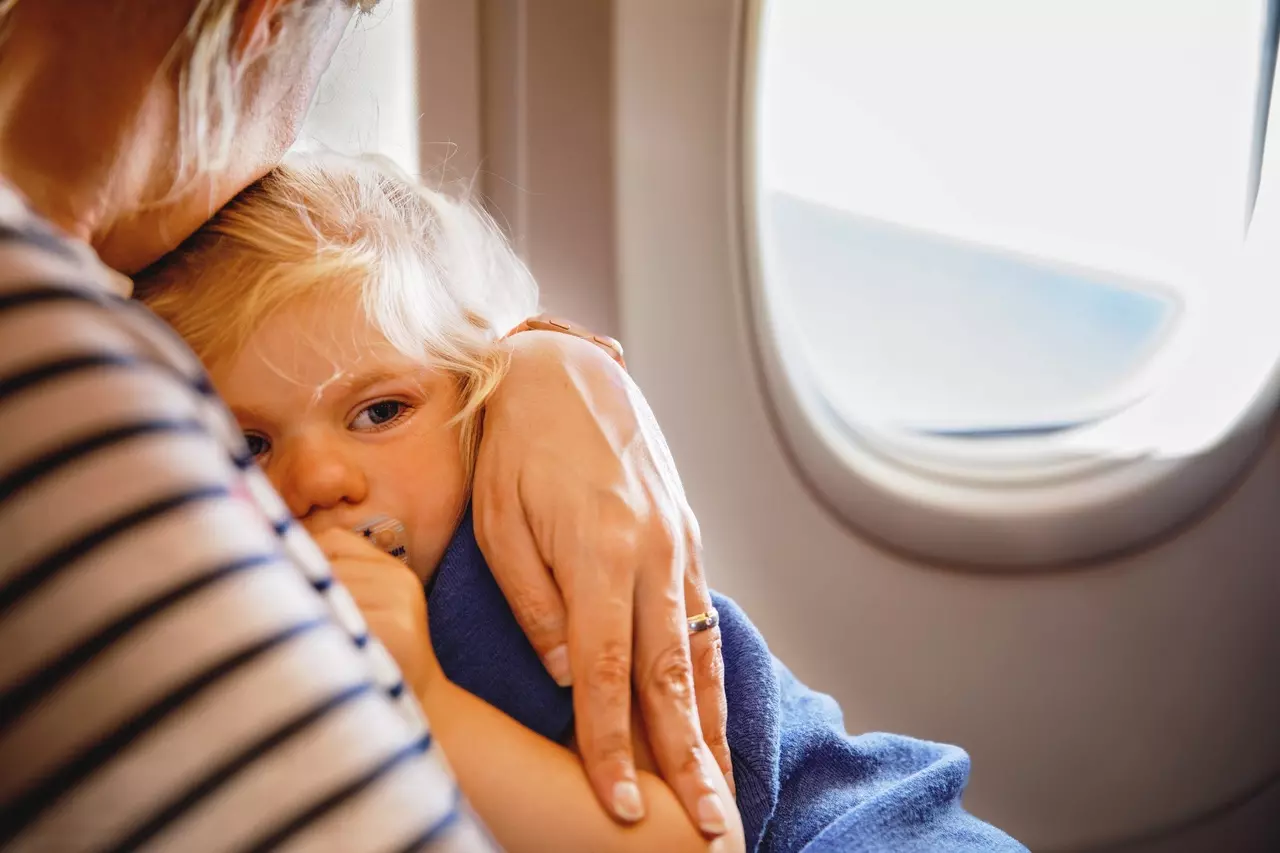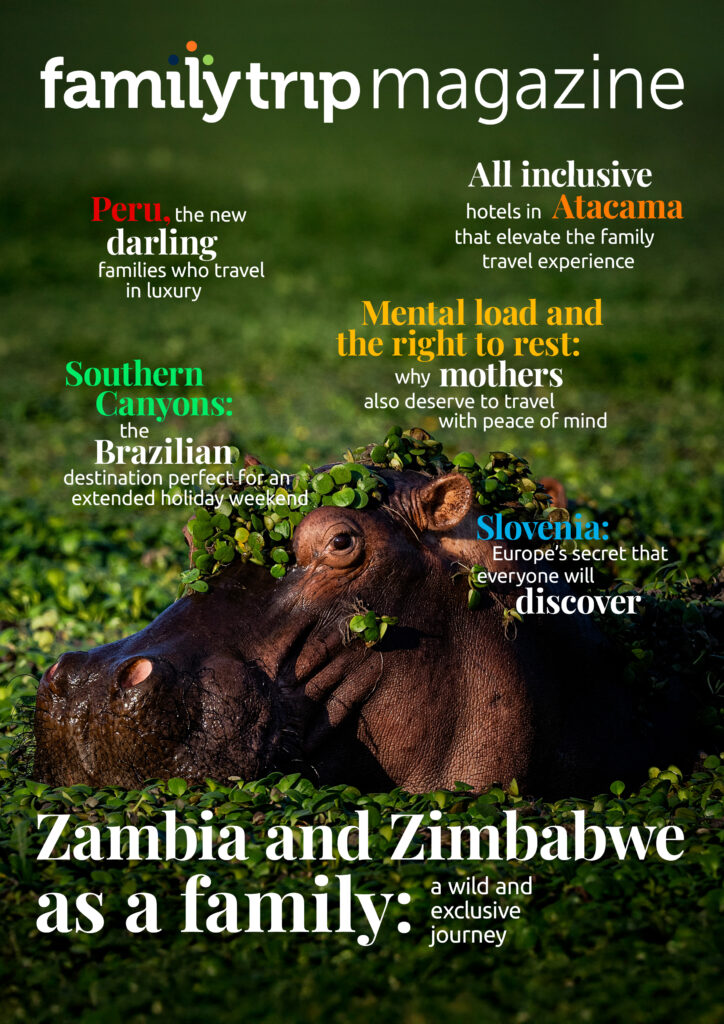
- Health
How to deal with fear of flying
Tips for facing fear of flying for both children and adults in the family and ensuring a safe and peaceful trip for everyone
By Natália Faria G. Viana
Air travel is an exciting experience for many families, but for some people, especially adults and children with flying anxiety, the thought of boarding a plane can trigger fear and discomfort. Understanding how to deal with this situation and help children feel safe during flight is essential to ensure a peaceful and pleasant family trip.
Tips for reducing anxiety when planning family air travel
- Prefer flights at good times that respect children’s sleep and eating routines to increase chances of them staying relaxed, avoiding additional stress for the responsible adult.
- When choosing an airline, check if there are options that allow cockpit visits, providing a more familiar and confident environment.
- The aircraft model and size can impact the sense of security, with larger planes usually feeling less turbulence.
- Reserve seats in advance to guarantee the family stays together.
- Prefer seats in middle rows or closer to wings, which are more stable areas. Avoiding emergency exits or staying near them can also be an option, as some fear being close to exits.
Flying anxiety: differentiating fear from phobia
Before addressing how to face children’s and adults’ fear of flying, it’s important to differentiate first-time flying anxiety from anxiety related to previous negative experiences during air travel. Some people may present mild anxiety linked to simply traveling by plane, while others may develop a true phobia, mainly after traumatic experiences.
Phobia is a manifestation of anxiety disorder characterized by irrational fear regarding a situation, activity, place, object, or animal, even when there’s no real danger associated with them. In other words, anxiety experienced by a phobic person is disproportionate to the circumstance in question.
In this context, aerophobia, also known as aviophobia, is the specific fear of flying in planes, helicopters, or other flying vehicles. In some cases, aerophobia may be accompanied by other phobias, such as claustrophobia (fear of closed or confined spaces) or acrophobia (fear of heights). When such phobias become incapacitating or interfere with quality of life, it’s essential to seek specialist help. But for mild anxieties linked to air travel, some tips can help face the situation more calmly.
Children with fear of flying
Despite most children loving to board a plane, it’s common for some to feel anxiety before or during travel, especially if it’s their first time flying. It’s important to try to understand the causes of this anxiety to adopt more adequate strategies to help the child feel safer during flight. Knowing the child well, dialoguing, and observing them in other potentially anxiety-generating situations can help differentiate if flight-related anxiety is simply fear of the unknown or may be related to other issues. It may be, for example, that the fear isn’t of an accident but of feeling sick and not being able to leave that situation until the plane lands.
Including with younger children who still have difficulty communicating well, it’s important to try discovering with a pediatrician if anxiety – often perceived through crying – goes beyond psychological issues, possibly being related to physical discomfort like nausea, clogged ears, sound sensitivity, and dizziness.
Before flying with children
If it’s confirmed that anxiety is purely psychological, the first thing to do is welcome the child with empathy, explaining that it’s normal to have fears and that we all have things that make us a bit anxious. Next, it’s important to emphasize that being afraid to do something isn’t a reason not to do it, as often our fears are unfounded and can be overcome. Examples can help understanding, like remembering when the child was afraid to ride a Ferris wheel for the first time but later realized there was nothing to fear. For little ones, it’s worth using playful analogies, like using the “boogeyman” story to show that what we imagine can be less scary than it seems.
Especially if it’s the child’s first time flying and they already have a tendency toward fear or anxiety generally, some strategies can help prepare them before the flight. For younger ones, it’s worth using creativity to show that flying is an exciting adventure that takes us to magical places. Make positive associations, using dismountable toy planes or games with drawings, cutouts, and collages to build a plane as a family while each imagines fun stories. For older ones, it pays to try explaining how a plane can fly and move us safely from one place to another.
If possible, take the child to an airport on dates before travel so they familiarize themselves with planes and the noises they make, as well as see how people behave naturally and not with fear. Also consider taking a family trip to museums displaying planes or watching films and series showing positive scenes of people traveling by plane peacefully.
How to encourage children to lose fear of flying
Some analogies and playful examples can help demystify flying fear for children, showing it’s possible to face anxiety and enjoy the wonders air travel can provide. Remember to emphasize that being afraid to do something new is normal, but with courage and confidence, we can overcome our fears and discover incredible experiences along the way. Following are some ideas about what to say to encourage children to lose fear of flying:
- “The plane is like a car, but in the clouds! Just as you feel safe inside a car with a seatbelt, the plane also has safety devices that protect everyone aboard.”
- “Imagine the plane is like a great magical bird that can take you to wonderful places. It’s designed by very intelligent engineers who make sure everything is safe and working perfectly.”
- “Imagine the plane as an enormous modern carriage that takes us places like in a fairy tale. And we all know fairy tale characters overcome their fears to achieve their dreams.”
- “Think of flying fear like being in line for a Ferris wheel or roller coaster. Sometimes anxiety arises before boarding, but after the ride starts moving, you realize excitement overcomes fear.”
- “Flying in a plane is like swinging on a park swing. Even though it may seem a bit scary at first, soon you realize it’s exciting and fun.”
- “Flying fear is like getting butterflies in your stomach before diving into a pool. At first, you may hesitate, but when you finally enter the water, you realize you were worried for nothing.”
- “Sometimes we fear the unknown, like meeting a new school or making a new friend. Flying can be scary because it’s a new experience, but many people end up loving it and wanting to do it again.”
- “Flying fear is like being afraid to ride a bicycle for the first time. Remember when you were insecure about getting on the bike, but after trying a few times, you realized it was an exciting and safe activity?”
- “Remember when you learned to swim. At first, you may have felt afraid of drowning, but over time, you gained confidence and skill. The same happens with flying.”
- “Even superheroes have fears, but they don’t let that stop them from facing challenges and saving the day. Just like superheroes, we can face our fears and achieve incredible things.”
Arriving at the airport and boarding with children
Plan to arrive at the airport and board well in advance to avoid eventual adult stress caused by possible delays affecting the child. By arriving early, you’ll have time to check in calmly, go through security procedures unhurriedly, and still have extra time for the child to explore the departure terminal relaxedly. Additionally, when adults are relaxed and show security in the situation, this transmits confidence to the child, which can help them feel safer and more comfortable during the entire boarding process.
If possible, use the time before boarding to play with the child and relax. Some airlines offer children’s areas in airports, with toys and spaces to play, which can be a great way to distract the child and make waiting more pleasant. By creating a light and relaxed environment before the flight, you’ll be contributing to the child feeling more relaxed, safe, and confident to board.
When boarding, present whoever is piloting the plane as a superhero who has the important mission of taking all passengers to a safe place. Knowing we have a heroic figure in command makes us more confident during flight. Also present flight attendants as guides or guardian angels who are there to care for and protect all passengers, ensuring they have a safe and comfortable trip.
During flight with children
It’s important to remember that moments like takeoff and landing, as well as eventual turbulence, can be most unsettling for anxious or sensitive children. In these situations, seats must be placed in a vertical position, tray tables need to be closed, and bulky objects need to be stored, which can restrict the use of some toys. Therefore, it’s essential to know how to entertain the child creatively somehow – like with verbal guessing games or memorization. Additionally, depending on fear level, you need to be prepared to offer greater emotional welcome and support in these moments, avoiding, for example, napping, talking to another person, or going to the bathroom during turbulence, leaving the child helpless.
During the flight, try keeping the child entertained and distracted with toys and activities they like. Have some of their favorite games, colorful books, colored pencils and paper for drawing, or even a tablet with educational and fun apps in carry-on luggage.
It’s also interesting to involve the child in the flight experience, showing how exciting it is to observe clouds from above and follow the plane’s journey through the flight map on the onboard entertainment system. Explain flight stages like takeoff, cruise altitude, and landing simply and playfully.
If the child is old enough, talk about landscapes that can be seen from above, like rivers, mountains, and cities, making them excited to observe through the window during the journey. Creating an adventure and discovery atmosphere during flight can help divert focus from fear and transform the experience into something positive and enchanting.
Finally, even if the flight offers meals, it’s important to have snacks and drinks the child likes on hand, ensuring they’re comfortable and satisfied throughout the flight.
Parents’ care and attention are fundamental to providing a peaceful and safe trip for children, making flying an opportunity to create special family memories.
When another family member has fear of flying
If a family member, like one of the parents, an older sibling, or one of the grandparents has fear of flying, it’s understandable there’s concern about not passing this anxiety to the child. When the child already has certain comprehension capacity, dealing with the family member’s flying fear openly and honestly can be beneficial, as transparency in communication can help build confidence and security in the child.
If the decision is to be open with the child about a family member’s flying fear, the approach should be careful, taking care not to transmit panic or insecurity, as well as not ridiculing the fear. Explaining that fear is a natural emotion and everyone has their own insecurities can help the child understand there’s no problem feeling afraid. It’s important to emphasize that the adult is dealing with their fear and this doesn’t affect flight safety. A possible analogy is explaining that just as some people fear sleeping with lights off or sliding down a slide, others may fear flying, but this doesn’t mean the activity is dangerous.
To calm the family member who fears flying, it’s valid to remember each person deals with anxiety differently. Some strategies may include using breathing techniques, like inhaling and exhaling deeply to calm nerves, or using distractions like listening to music, watching a movie, or reading a book during the flight. Additionally, there are specific programs and therapies for flying fear that can help the person deal better with this situation.
When the adult responsible for the child during flight has flying fear
It’s fundamental that the responsible adult can guarantee the child’s well-being and safety during the flight. Therefore, when the only adult responsible for the child during travel feels anxiety about flying, the situation deserves special attention. The approach can vary depending on whether it’s the first time the adult will fly or if they’ve had previous experiences with air travel. Adult anxiety can be perceived by the child, which may increase flight discomfort for both. In these cases, it’s recommended to seek strategies to overcome or alleviate eventual adult anxiety crises, like using breathing and distraction techniques. Additionally, it’s important to consider anxiety crisis severity and the involved child’s age range.
First time flying: It’s essential to reflect on the situation calmly and try understanding insecurity origins. It’s essential to share your feelings with a family member, trusted friend, or psychologist before travel. Talking about anxiety can help relieve stress and even be an opportunity to receive tips from people who’ve had this experience. Knowledge is also one of the best ways to combat fear. Learning about the flight process, how boarding, takeoff, landing work, and what standard procedures are in emergency cases helps understand how aviation is safe, which can reduce anxiety.
Previous flight experiences: If the adult has flown before and still has fear, it’s important to identify its origin and if there are specific issues that trigger it. In these cases, it may be useful to seek therapies or specific programs for flying fear before travel, so the adult feels more emotionally prepared.
Previously communicating with airline: If the responsible adult has a history of anxiety crises during flight or similar situations, like inside a subway, it may be valid to previously inform the airline about this situation, so they’re aware and can offer special support to both adult and child they’re responsible for, if necessary.
Anxiety crisis severity: If the responsible adult presents severe anxiety crises related to the situation, it’s advisable to evaluate if they’ll be able to care for the child if a crisis occurs during flight. In these cases, it’s recommended they not be the only family adult to accompany the child, so there’s support from another if necessary.
Child’s age range: The child’s age can also influence recommendation. If the child is more independent and has sufficient maturity to travel alone, they can count on crew support if necessary. However, if the child is younger and needs more constant care, it’s fundamental that the responsible adult can care for them during the entire trip.
How not to let flying fear ruin family travel
Keep in mind that each person is unique, therefore strategies for dealing with flying fear may vary. Patience and empathy among family members are essential to support each other in this process. Evaluating when flying fear can be overcome by the family itself or when it’s necessary to seek medical or psychological help before considering air travel is fundamental to guarantee everyone’s safety and well-being.
To not limit family destination options, especially when one of its members is in treatment and doesn’t yet feel ready to face flying anxiety, there are alternatives. Ship travel or car or bus “road trips,” staying at destinations along the way, can be viable options when flying fear cannot be overcome short-term. These alternatives allow the family to continue exploring new places farther from home without needing to fly.
Furthermore, in a first attempt to face flying fear, it may be prudent to opt for flights to nearby destinations. Thus, if it becomes necessary to leave the plane due to a panic attack that makes takeoff impossible, the family can, for example, continue traveling by car or bus and not lose accommodation and tour reservations. In this case, being able to count on travel agency support makes all the difference, as it avoids having to deal with additional stress of rescheduling and eventual cancellations and refund requests.
The important thing is maintaining optimism, as by seeking to understand fear causes and adopting measures to face it with adequate support, flying anxiety can be overcome, expanding family vacation destination possibilities. With mutual support, patience, and understanding – as well as eventual medical help – it’s possible to face this fear and enjoy incredible adventures, creating unforgettable family memories in all corners of the world. But never losing sight that more important than being able to travel anywhere is you being together.

Things the Way Family love to pack in their suitcase:
Gate
Eletronics for the travel: smartphone, drone, câmera, charger,…
Destiny
UV clothes, bikinis, caps, diving goggles, snorkel mask and other accessories…

















